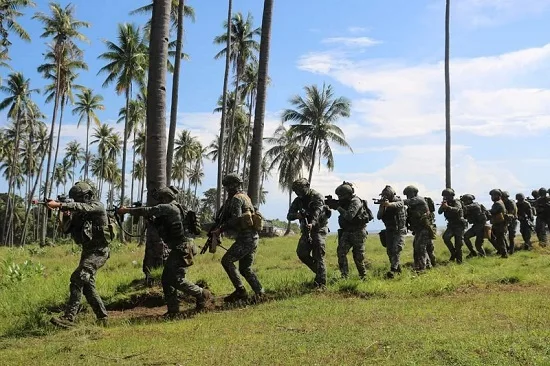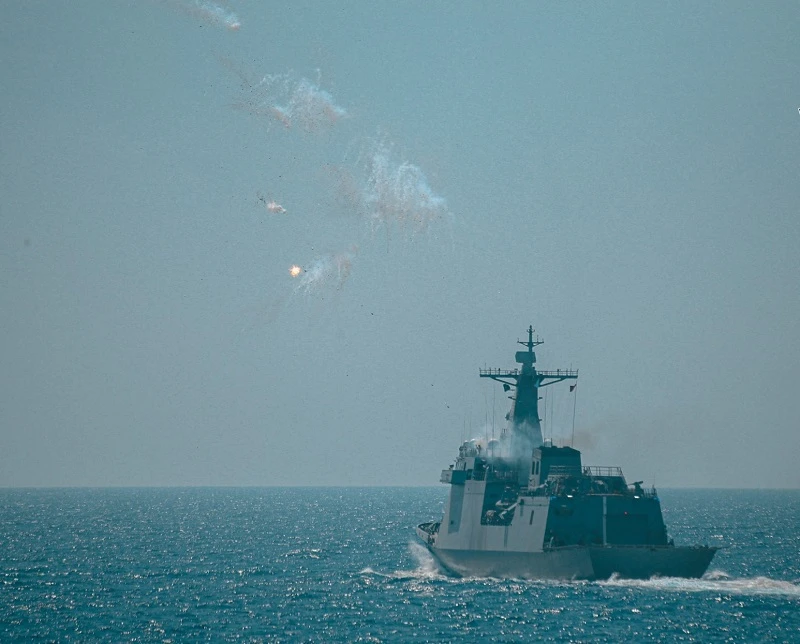

India is not only equipping Manila with the medium-range ramjet supersonic Brahmos cruise missiles but is also batting to upgrade the Philippines' artillery and conduct military courses for its armed forces personnel (Images courtesy: Twitter/@Philippine_Navy)
India and the Philippines have vowed to further develop defence equipment and industry ties spotlighting their shared objectives and approaches to the security environment in the Indo-Pacific region.
A series of significant engagements between the top-level officials of the two countries took place this week, culminating in the 4th Joint Defence Cooperation Committee meeting held in New Delhi on Friday.
During the Delhi discussions, both sides reviewed the ongoing bilateral defence cooperation and discussed effective and practical initiatives to further expand the engagements.
The co-chairs, said a statement from the Ministry of Defence, reaffirmed their commitment to implement 2006 agreement concerning defence cooperation, based on mutual trust and understanding, common interest and shared values of democracy and rule of law.


“Both sides agreed to initiate measures to enhance cooperation in Defence Industry and Technology domain and look forward to greater synergy in effectively deepening bilateral cooperative engagements across the spectrum,” it stated.
Faraway in Manila, Shambhu Santha Kumaran, Ambassador of India to the Philippines, also had a busy week meeting the country’s top defence and security chiefs.
On Thursday, Kumaran met with Carlito Galvez Jr., the Philippines’ new defence chief at Camp Aguinaldo – the General Headquarters of the Armed Forces of the country.
The top official of the Philippines’ Department of National Defence (DND) noted the robust engagement between the two countries, including in the field of defence and security.
The two officials also hoped to increase military education and training exchange, as well as further develop defence equipment and industry cooperation.
Galvez looked forward to the outcomes of the Joint Defence Cooperation Committee meeting and also the 2nd Service-to-Service (STS) meetings hosted by the Ministry of Defence of India and the Indian Armed Forces in New Delhi.
“Substantive discussions on consolidating ongoing momentum in bilateral defence ties for a stable Indo-Pacific including through expanded training, joint exercises and enhanced capabilities,” tweeted the Embassy of India in the Philippines.
A day earlier, on March 29, Kumaran also held discussions with Eduardo Ano, the National Security Advisor (NSA) of the Philippines on national security cooperation including maritime security, counter-terrorism, and cyber-security as well as expanding capacity building engagement.
As reported by IndiaNarrative.com earlier, India is not only equipping Manila with the medium-range ramjet supersonic Brahmos cruise missiles but is also batting to upgrade the Philippines’ artillery and conduct military courses for its armed forces personnel.
At the crossroads of the busiest sea lanes in the world, including the Strait of Malacca, both India and the Philippines realised the critical role the Brahmos deal will play to safeguard the Indo-Pacific region.
Prime Minister Narendra Modi has been emphasising that the island country of Southeast Asia plays an important role in India’s Act East Policy and its Indo-Pacific Vision.
The two countries continue to conduct high-level dialogue, education and training exchanges, information sharing, and defence industry and logistics cooperation.
In February, 21 Philippine Navy personnel completed the operator training of the Shore Based Anti-Ship Missile System (SBASMS) and were awarded their interim missile badges and pins by no less than the Indian Navy Chief of Naval Staff, Admiral R Hari Kumar.
The training, which ran from January 23 to February 11, focused on the operations and maintenance of some of the most important logistics package of the SBASMS that will be delivered to the Philippines which has been worried about China’s strategic expansion into the South China Sea.
“The induction of the BrahMos missile into the Philippine Marine Corps will strengthen your maritime capability and will also contribute to our collective maritime security within the region,” said Admiral Kumar during his valedictory remarks.
For the Philippines, protecting the strategic strait of Luzon — a link between the Philippine Sea and the South China sea is vital. The strait has been in the limelight recently because of Taiwan. The Luzon strait threads through Taiwan and the Luzon Island of the Philippines.
The US naval ships heading to the South China Sea, where China is falunting its military muscle, have to pass through the strait of Luzon.
The Brahmos acquisition will not give a boost to the Philippine Navy’s capability to defend the country’s maritime borders but also further complement the efforts of its surface assets in patrolling the Philippine waters.
Also Read: After Brahmos deal, India ready to train Philippines armed forces
Prime Minister Narendra Modi met Bangladesh Chief Adviser Muhammad Yunus on the sidelines of the…
Prime Minister Narendra Modi's vision and policies are injecting dynamism into BIMSTEC as India's leadership…
Prime Minister Narendra Modi on Friday held a meeting with Senior General of Myanmar, Aung…
Legendary actor and filmmaker Manoj Kumar, a stalwart of Indian cinema, passed away on April…
The Indian Army's Field Hospital continued with its medical support in Myanmar after the devastating…
Prime Minister Narendra Modi and his Thailand counterpart Paetongtarn Shinawatra held bilateral talks on Thursday…